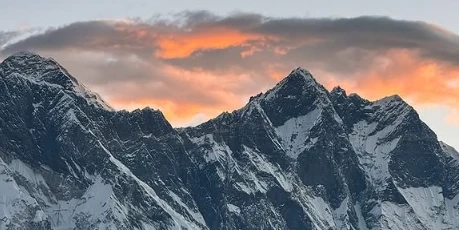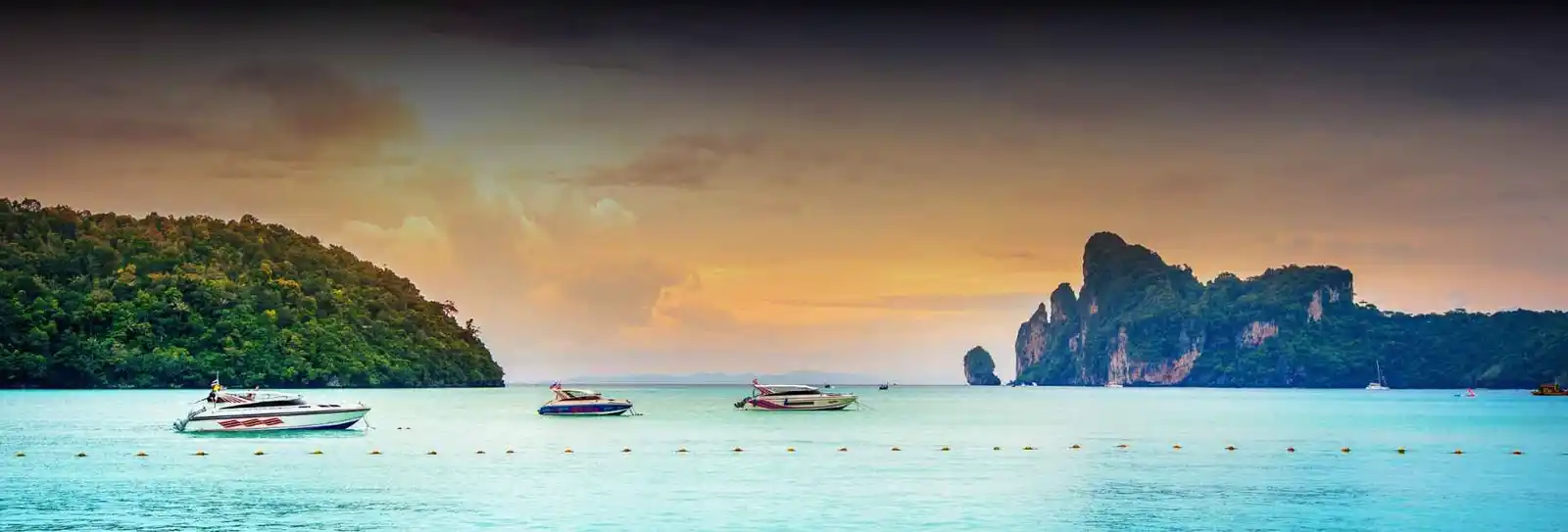
Indian Himalayan trekking possesses some of the most compelling arguments of raw visual appeal spread out at one's feet. Indian scenery is hardly irresistible, with the virtue of sudden change with location and altitude. It is easy to picture trekking through pine forests on lower slopes, onto level alpine meadows scattered with wildflowers and onto wind-blown ridges with vistas over snow-crested peaks. The Himalayas also have some of the world's highest and most renowned mountains, like Nanda Devi, Trisul, and Kamet, that tower up between the valleys like evil sentinels, ablaze with gold at sunrise, reds and mauves at sunset. No two trekking trails are alike. In Uttarakhand, the Valley of Flowers explodes into a kaleidoscope during the monsoon with over 600 varieties of flowers blanketing the trail. The Hampta Pass trek in Himachal provides trekkers with a stunning contrast between the verdant green valley of Kullu and the barren wasteland of Lahaul.In Sikkim, the Goechala Trek offers centre-stage glimpses of the massive Kanchenjunga, the world's third-highest mountain, bursting out from time to time from a sea of clouds, and even off-the-beaten-path treks like the Kugti Pass or Dzongri-La surprise trekkers with glacial lakes, waterfalls cascading down cliffs, and centuries-old Buddhist monasteries atop cliff tops. Beyond the landscapes, the naturalness of the surroundings truly gets its grip. Crystal blue sky at great height displays a starry night, and pure mountain air fills lungs with life and tranquillity. Nature becomes colored more colourful, silence becomes quieter, and nature becomes cleaner and holier. The trail yields to a new vista at every step, whether the concealed brook, the surprise terrain, or the remote glade resonant with a song of birds in the distance.Trekking and HikingTrekking and hiking in the Indian Himalayas provide experiences ranging from easy walks in nature to demanding multi-day treks, and therefore, it is an adventure for all, from beginners to seasoned trekkers. The beauty of such treks is not only in their physical challenge, but also in the varied landscapes they reveal and in providing a closer contact with nature. Whether you hike a traditional pilgrim trail, trek in isolated mountain villages, or ascend high-altitude peaks, every trek is unique. Hiking, which was once a day hike or weekend trek, is very popular in the lower Himalayas. Treks like the Kedarkantha Trek in Uttarakhand are a great starting point for hiking in the mountains. It's a relatively brief, 4-day trek, but one with expansive vistas of the surrounding valley, forest, and rocky ridges of the area. The trek is likely best known for the enchanted pine forests, and the final climb provides the hikers with dizzying 360-degree vistas of some of the highest western Himalayan peaks, including Swargarohini and Black Peak. Whether you need a relaxing or demanding hike, there is something for everyone in the Indian Himalayas, providing a physically demanding but spiritually rewarding experience.Spiritual and Cultural ExperienceSo much more than a tough hike, hiking in the Indian Himalayas is a highly spiritual and culturally rewarding experience. There is an antediluvian style of etiquette, divine creeds, and ancient traditions all around, and therefore a deeply religious experience for the one who wants to be part of something more than himself. As you drive across these mountains, you will not only witness the stunning beauty but also the thousand-year-old temples, secluded monasteries, and small villages where religion and living blend and become part of ancient traditions. Hindu and Buddhist gods have had a home here for centuries in the Himalayas, and certain of the trekking routes transport one to destinations of unmatched spiritual significance. Look at the Badrinath Trek, for example, which brings pilgrims as well as trekkers to one of the most revered shrines in India, that of Lord Vishnu. Pilgrims ascend snowy mountains and rugged trails here and pray for the gods' blessings in unmapped domains. Within the Buddhist enclave of Ladakh, treks like the Markha Valley Trek allow one to overnight at the ancient Buddhist monasteries such as Hemis and Thiksey, perched atop cliff sites with grand views over valleys. In addition to being quiet, monasteries are a cultural hub where you can see monks busy with ancient rituals, prayer, and carrying on centuries-old traditions. The spiritual environment of the monasteries and the higher altitude allow the trekkers to relax and refresh their inner selves.Adventure SportsThe Indian Himalayas are heaven not only for a trekker but also for an adventure park. There's more to the Himalayas than trekking, and there are numerous adrenaline-thrilling adventure sports here that allow you to engage with the mountains in a new and innovative way. Be an adrenaline junkie looking for the biggest challenge or an aspiring adventurer looking for something different, the Himalayas have it all for every body. The most popular adventure sport is river rafting, especially in locations like Rishikesh and Manali. The thundering rivers that drain the Himalayas provide the perfect setting for an adrenaline-pumping rafting experience. The rapids range from easy stretches for novices to heart-stopping Class IV and V rapids that even experienced rafters struggle to conquer. The quaint beauty of snow-white mountains and emerald-colored valleys is but an added pick-up to the adrenaline rush, and it translates into a lifetime experience for others who want to see the Himalayan rivers.To gain a bird's eye view of the Himalayas, paragliding as an adventure sport promises the absolute high. World-renowned and world-famous paragliding sites for travellers like Bir-Billing in Himachal Pradesh are spoken of in superlatives, with sailings far above the picturesque valleys providing trekkers stunning panoramic views of the villages, mountains, and forests around. Suspended halfway in mid-air, as well as the tremendous view, is a Himalayan landscape that not many manage to witness, let alone recall. Rock climbing and mountain biking are yet another adrenaline-pumping sport. Climbing Manali's rock faces that surround the town or mountain bike riding on the rugged Spiti Valley trails, these activities allow you to feel the harsh mountain landscapes more brutally. Climbing is a physical endurance test, and mountain biking is an adrenaline-packed mode of transport across forbidden territory that cannot be traversed otherwise by any other wheeled vehicle. The adventure and freedom of these activities are simply perfect for such individuals who desire to experience physical adventure along with the adventure of living in the wild out there.Wildlife and BiodiversityIndian Himalayas are not only a paradise for trekkers but also a paradise for varied wildlife and vegetation. They are among the Earth's most biodiverse places, home to numerous rare and threatened species that find refuge within the outstanding landscapes of high mountains and rainforested habitats. Whether your fascination is with animals or you merely wish to observe nature as it is, to hike through the Himalayas is to witness some of the world's most wonderful animals and environments. As you ascend from foothills to higher elevations, you will be traversing through different eco-zones with their respective flora and fauna. Lower slopes are covered with deodar, oak, and rhododendron forest areas in plenty, which are the homes of some of the following animals, like a rare leopard, musk deer, and wild boar. Dense jungle is rich sustenance to variegated bird life, and India's national bird, the Himalayan monal, reveals its multicoloured feathers in meadows at high altitudes. The Himalayan regions of Himachal Pradesh and Uttarakhand are full of birds and a paradise for bird-watching. On your way further north, you find alpine grasslands and rock faces where you catch glimpses of the region's most mythological and mystical animals.The snow leopard or the Himalayan ghost wanders Ladakh and Himachal Pradesh's mountain ridges rarely, but it most frequently gets caught by careless trekkers. Some other high-altitude creatures that deserve a mention are the brown bear noble, blue sheep, and the Himalayan tahr. Even in Kashmir's forests, you spot the hangul deer, a rare creature that exists only in these Himalayas. The thick cover is also part of the Himalayan range, where thousands of wildflowers, medicinal plants, and alpine plants are found nowhere else. Valley of Flowers National Park, a UNESCO World Heritage site, is a flower garden with more than 600 species of plants and animals that carpet the grasslands in a kaleidoscope of colours during the monsoon seasons. The park is also an important breeding ground for a wide range of insects, including butterflies, which add to the colourful medley of life.Meditation and Yoga RetreatsIndian Himalayan trekking is not only physically challenging but also the most appropriate place to feel introspection, inner happiness, and spirituality. The mountains' peace and solitude provide the perfect location to carry out meditation and yoga retreats, wherein tourists can isolate themselves from the chaos of modern civilisation and reinvent themselves. Whether you’re an experienced yogi or someone seeking to find balance and calm, the Himalayas provide the ideal setting for rejuvenation of the mind, body, and spirit. The peaceful surroundings of the Himalayas have long attracted seekers of spiritual solace, and many trekking routes pass through places that are known for their spiritual energy. Yoga and meditation retreats in such places are designed to enable you to immerse yourself in peace and awareness amidst nature's wonder. Rishikesh, famously the 'Yoga Capital of the World,' has been attracting spiritual travellers over the decades.The town of the Ganges River is littered with hundreds of yoga ashrams and meditating resorts where one stays for days or weeks and studies yoga, meditation, and spiritual healing from the gurus. Further up in the Himalayas, the quiet of towns like Dharamshala and McLeod Ganj provides an ideal milieu to those who want to get in touch with their inner self. Dharamshala is famous for being home to the Dalai Lama, not only a Buddhist site but also a meditation retreat facility where one has the chance to reconcile one's spirituality and love for nature. Yoga enthusiasts flock to Tibetan Buddhist monasteries here so that they can be able to attend classes in meditation, participate in silent retreats, and get immersed in the serene pace of day-to-day life.StargazingArguably, the most enchanting aspect of Indian Himalayan trekking is the possibility of stargazing some of the world's freshest, purest skies. The remote destinations, being distant from city and town light and noise pollution, are the ideal environment for a night's sleeping under the stars to be long remembered. The higher one travels, the more frigid the air, the more frigid the nights, and the panorama of the night sky becomes all the more spectacular. Trekkers witness the extent of cosmic beauty yet to be explored, largely unexplored in the process of urbanisation elsewhere in the Indian Himalayas. Transparency of high-altitude air gives additional size and shine to stars, blanketing the dark sky with constellations, galaxies, and fireflies. Places like Ladakh and Spiti Valley, being trekking locations, are famous for stargazing treks, with blue skies and high-altitude camps offering views on a large canvas of the Milky Way, stars, and even distant planets. In regions like Ladakh's Nubra Valley, the dry desert-type climate and low humidity offer nearly unobstructed glimpses of the sky at night, making it one of the finest locations in the Himalayas to observe the stars. You can recline on your back in the stillness of the night and gaze upwards towards grand peaks as you are showered with millions of stars twinkling in the sky overhead.It's a sky under which the constellation Orion, the Big Dipper, and the Andromeda Galaxy are all within naked-eye reach, a sight that's humbling and breathtaking. Stargazing on a hike is not just an eyesight delight, it's a soulful and contemplative delight. The vastness of the universe tends to make you feel peaceful and composed, and you tend to reflect upon yourself as you gaze into the expanse. Trekkers will tend to say that the nights spent stargazing in the Himalayas are not just a goldmine in the trek, but a spiritual experience that lasts even after the trek. Aside from this, the Himalayas also offer astrophotography, through which the talented are in a position to observe the wonders of the nighttime sky with spectacular distinctness. High-tech or no high-tech camera, if observed with bare eyes or with a solitary one, the night skies are an extravaganza to behold that leaves the trekker vulnerable to nature's realm in a way that other places cannot match. If you’re seeking a deeper connection with the cosmos, stargazing in the Indian Himalayas is an experience that will stay etched in your memory forever. The serene surroundings, coupled with the brilliance of the stars, make it an essential part of any trekking journey in this majestic mountain range.Why Book with escape2exploreWhen exploring the Himalayan Trek and beyond, escape2explore stands out as a trusted name in adventure and experiential travel. Here’s why hundreds of travellers choose us for their getaways:Trusted, Well-Reviewed Local Operator: escape2explore has gained the trust of thousands of content tourists all over India. With persistent positive feedback and an unblemished reputation for delivering quality experiences, we assure your experience to be hassle-free, memorable, and value-packed. Our insider local knowledge guarantees that you to always be in safe hands.Seasoned Guides: Our trips are led by friendly, trained, and professional guides who are passionate about the outdoors and your safety. Whether it's a beach trek, a cultural tour, or a spiritual walk through temples, our team knows the terrain, the stories, and how to make each moment count.Safe & Curated Itineraries: Your safety is our number one priority. Each of our tour packages is thoughtfully crafted with safety measures, researched accommodations, and easy travel arrangements. We take care of the details so you can have the experience hassle-free and worry-free.Unique Experience That You Won't Find Anywhere Else: With escape2explore, you discover more than the tourist attractions. We go off the beaten track with hidden beaches, unusual treks, offbeat cultural destinations, and true interactions. Whether camping out beneath the stars or exploring a hidden beach cove, we present to you the other side of Coorg that not many get to encounter.Read: Rajgad Fort|Sudhagad Fort|Maharashtra Getaway|Treks in Maharashtra|Camera Tips


